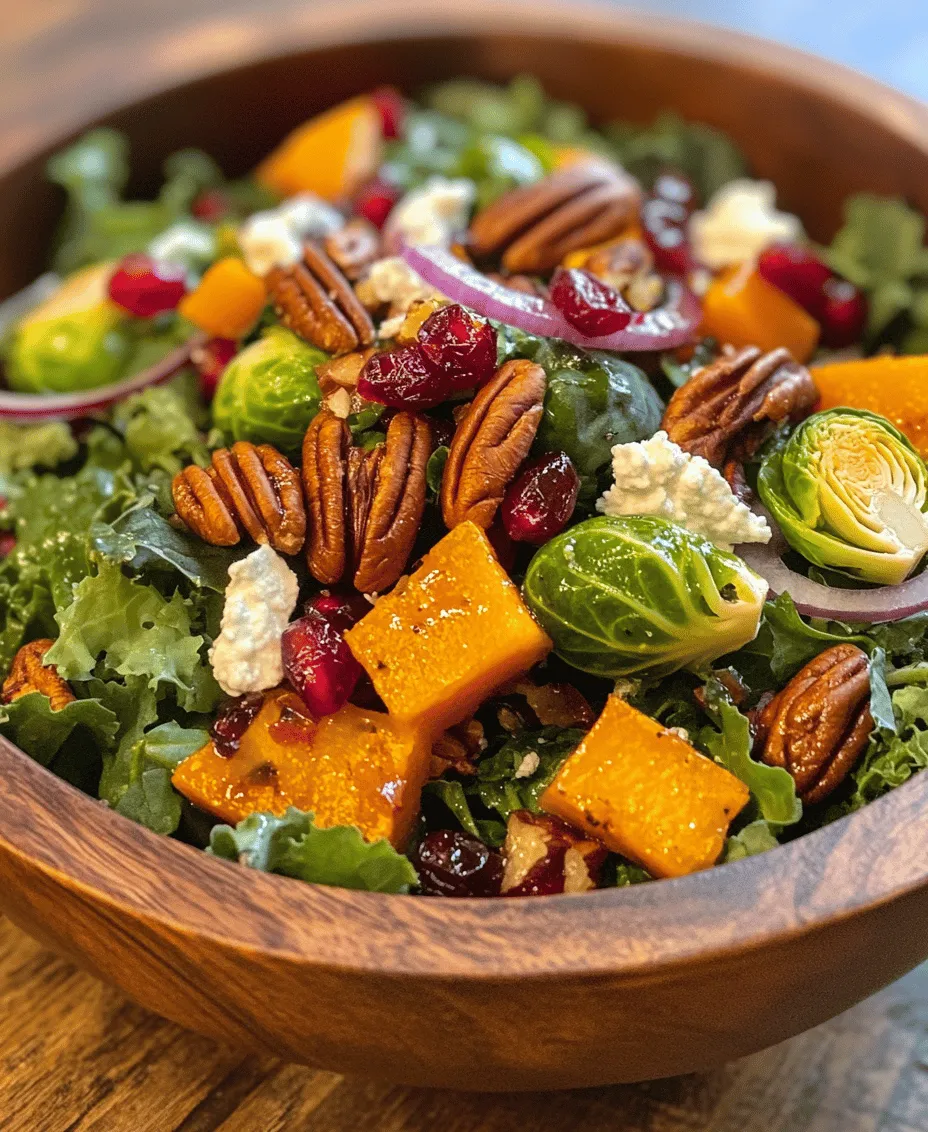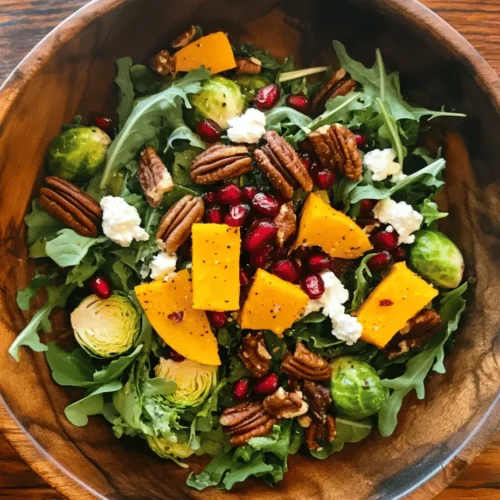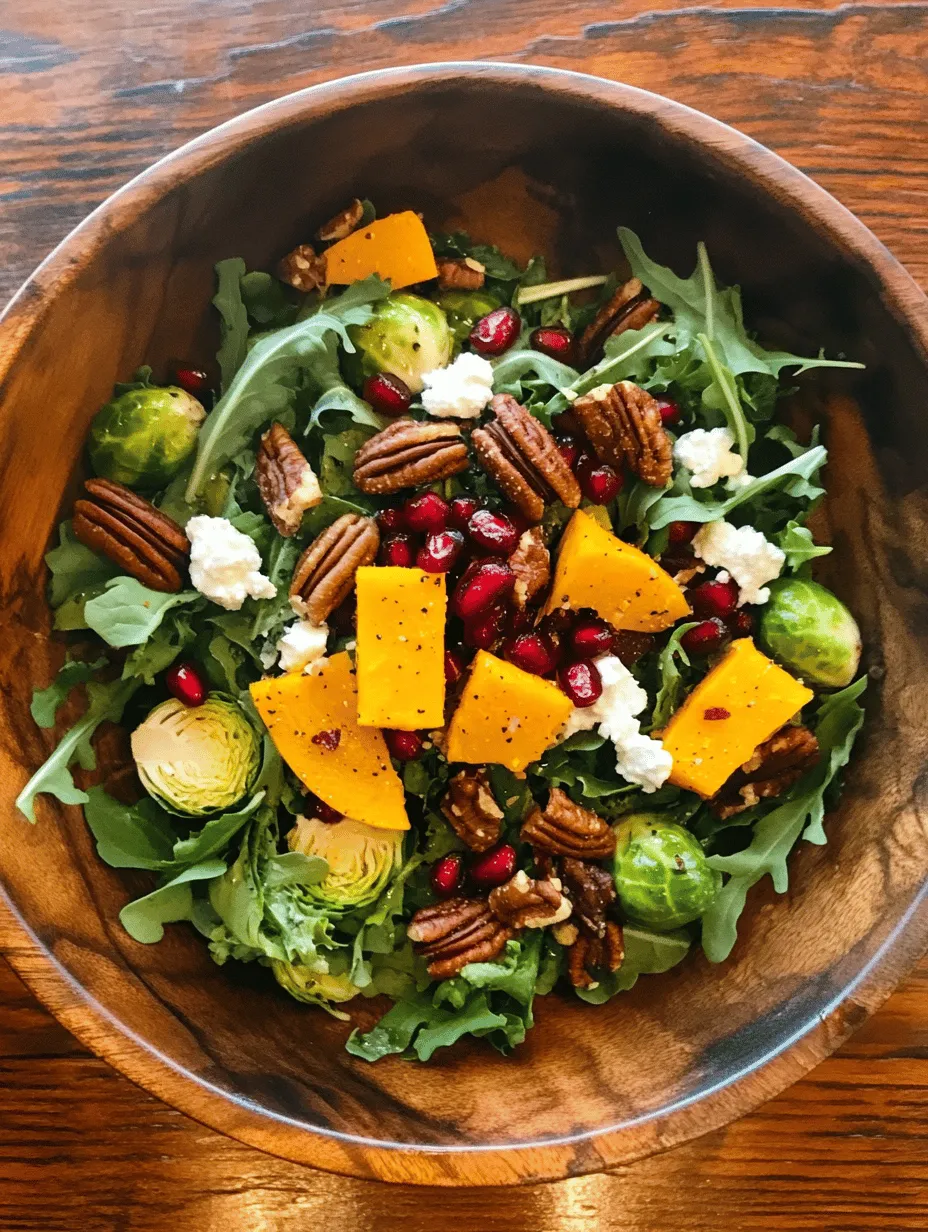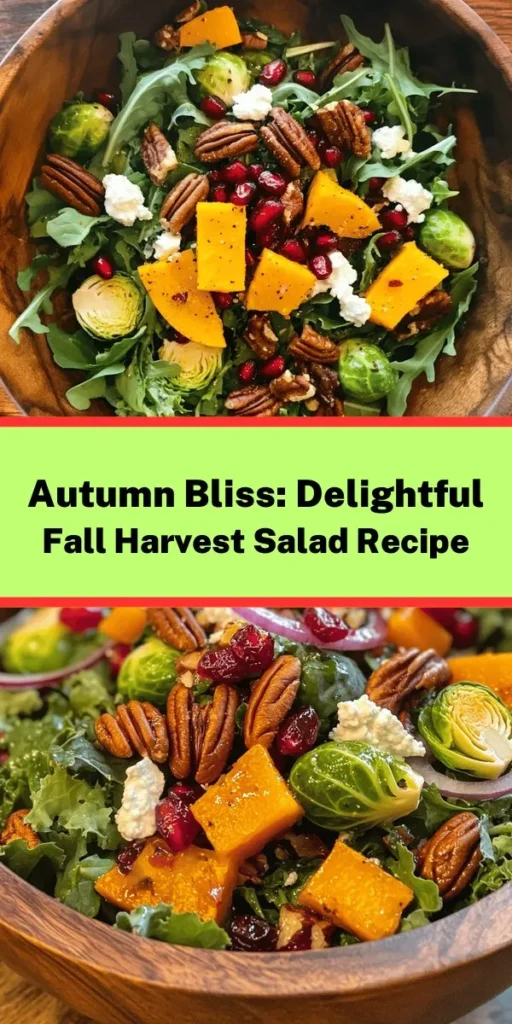Exploring the flavors of the fall season can be a delightful culinary adventure, and what better way to celebrate the bounty of autumn than with a vibrant Fall Harvest Salad? This recipe is not just a feast for the eyes; it’s packed with nutrients, offering a perfect balance of sweet, savory, and crunchy elements. With a medley of roasted vegetables, fresh greens, and a zingy dressing, this salad is a versatile dish that can be enjoyed as a side or a main course.
As the leaves begin to change and the air turns crisp, the ingredients of this salad reflect the essence of the season. Each component brings its own unique flavor and health benefits to the table, making it a fantastic choice for anyone looking to embrace the fall harvest. In this article, we will delve into the ingredients, preparation methods, and the nutritional benefits of each component, ensuring you can create this seasonal favorite with confidence.
Understanding the Ingredients
The Base: Mixed Greens
The foundation of any great salad begins with the greens, and for our Fall Harvest Salad, we’re using a mix of arugula, spinach, and kale. These leafy vegetables not only add a vibrant color to the dish but also contribute a wealth of nutrients.
– Arugula: Known for its peppery flavor, arugula adds a distinctive taste that enhances the overall flavor profile of the salad. It is rich in vitamins A, C, and K, as well as calcium and potassium, supporting bone health and providing antioxidant properties.
– Spinach: This versatile green is a powerhouse of nutrition. Spinach is low in calories and high in iron, magnesium, and vitamins A and C. Incorporating spinach into your salad not only boosts the nutritional value but also adds a mild, slightly sweet flavor that complements the more robust arugula.
– Kale: Often hailed as a superfood, kale is packed with vitamins K, A, and C, along with powerful antioxidants. Its slightly bitter and hearty texture provides a nice contrast to the other greens, making it an excellent addition to the salad base.
With this mix of greens, your Fall Harvest Salad will be not only visually appealing but also loaded with essential vitamins and minerals that promote overall health.
Roasted Vegetables: Butternut Squash and Brussels Sprouts
Roasting vegetables is a culinary technique that enhances their natural sweetness and flavor, making them a perfect addition to any salad. In this recipe, we feature butternut squash and Brussels sprouts.
– Butternut Squash: This autumn staple is rich in vitamins A and C, fiber, and potassium. Roasting butternut squash brings out its natural sugars, resulting in a caramelized exterior that adds depth to your salad. The creamy texture of roasted squash contrasts beautifully with the crunchy greens and provides a satisfying bite.
– Brussels Sprouts: Often underrated, Brussels sprouts are nutrient-dense vegetables that offer a wealth of health benefits. They are high in fiber, vitamins C and K, and provide significant amounts of antioxidants. When roasted, Brussels sprouts develop a nutty flavor and a crispy texture, making them a delightful addition to the salad.
Roasting these vegetables not only enhances their flavors but also creates a warm element in the dish, making it perfect for cooler fall days.
Sweet Additions: Dried Cranberries and Pomegranate Seeds
To contrast the savory elements of the salad, we include sweet additions that elevate the dish further.
– Dried Cranberries: These tangy little gems add a pop of color and a hint of sweetness to the Fall Harvest Salad. They are not only delicious but also packed with antioxidants, particularly vitamin C, which can help support your immune system during the colder months. Their chewy texture provides a pleasant contrast to the crunchy greens and roasted vegetables.
– Pomegranate Seeds: Known for their jewel-like appearance, pomegranate seeds bring a burst of sweetness and a satisfying crunch to the salad. They are also rich in antioxidants, vitamins C and K, and have been linked to heart health benefits. The refreshing tartness of pomegranate seeds helps balance the richness of the roasted butternut squash and Brussels sprouts.
Incorporating these sweet elements into your salad not only enhances the flavor but also adds a festive touch that celebrates the fall harvest.
Creamy Texture: Goat Cheese
To achieve a creamy texture and a touch of tang, we use goat cheese in our Fall Harvest Salad.
– Nutritional Advantages: Goat cheese is lower in calories and fat than many other cheeses, making it a healthier option. It is also high in calcium, which helps maintain strong bones. Additionally, goat cheese is easier to digest than cow’s milk cheese, making it suitable for those with lactose sensitivities.
– Flavor Balance: The creamy richness of goat cheese complements the sweet and savory elements of the salad. Its tangy flavor provides a nice contrast to the sweetness of the roasted vegetables and dried fruits, creating a well-rounded taste experience.
The addition of goat cheese not only enhances the flavor but also adds a luxurious mouthfeel, making each bite satisfying.
Crunchy Elements: Candied Pecans
To introduce a delightful crunch, we add candied pecans to the Fall Harvest Salad.
– Appeal of Candied Pecans: These sweet and crunchy nuts offer a wonderful contrast to the soft roasted vegetables and creamy goat cheese. Their caramelized flavor adds depth to the salad and elevates it to a gourmet level.
– Health Considerations: While pecans are a great source of healthy fats, protein, and fiber, moderation is key. Candied pecans are typically coated in sugar, so it’s essential to be mindful of portion sizes. However, when used sparingly, they can contribute valuable nutrients and a satisfying crunch to your salad.
The Dressing: A Perfect Blend
No salad is complete without a delicious dressing, and for our Fall Harvest Salad, we’ll create a simple yet flavorful blend that enhances all the ingredients.
– Ingredients: The dressing consists of high-quality olive oil, apple cider vinegar, and a touch of maple syrup. Olive oil is rich in healthy monounsaturated fats and has been linked to heart health. Apple cider vinegar adds a tangy flavor and may aid in digestion, while maple syrup provides a natural sweetness that balances the acidity of the vinegar.
– Flavor Contribution: Each component of the dressing plays a vital role in enhancing the overall flavor of the salad. The olive oil gives the dressing a smooth texture, while the apple cider vinegar adds brightness that cuts through the richness of the goat cheese and roasted vegetables. The maple syrup ties everything together, providing a hint of sweetness that complements the dried cranberries and pomegranate seeds.
Preparation Steps
Creating the Fall Harvest Salad involves a few simple steps that will ensure each ingredient shines. Let’s walk through the preparation process.
Preparing the Roasted Vegetables
1. Preheat your Oven: Start by preheating your oven to 400°F (200°C). This high temperature will help achieve perfect caramelization on the vegetables.
2. Prepare the Butternut Squash: Peel and dice the butternut squash into uniform cubes, about 1-inch in size. This will ensure even cooking. Toss the cubes in a bowl with olive oil, salt, and pepper until well coated.
3. Prepare the Brussels Sprouts: Trim the ends of the Brussels sprouts and slice them in half. Just like the squash, toss them in olive oil, salt, and pepper.
4. Roast the Vegetables: Spread the butternut squash and Brussels sprouts on a baking sheet in a single layer. Make sure they are not overcrowded, as this will prevent them from roasting properly. Roast in the preheated oven for about 25-30 minutes, or until the vegetables are tender and golden brown, stirring halfway through to ensure even cooking.
5. Cool Before Adding to Salad: Once roasted, remove the vegetables from the oven and let them cool slightly before adding them to the salad. This will help maintain the crispness of the greens.
Making the Dressing
1. Combine Ingredients: In a small bowl or a jar with a lid, combine 1/4 cup of olive oil, 2 tablespoons of apple cider vinegar, and 1 tablespoon of maple syrup.
2. Whisk or Shake: If using a bowl, whisk the ingredients together until well combined. If using a jar, securely close the lid and shake vigorously until the dressing is emulsified.
3. Taste and Adjust: Give the dressing a taste and adjust the seasoning if necessary. You may want to add more vinegar for acidity or more maple syrup for sweetness, depending on your preference.
With these steps, you are well on your way to creating a delicious Fall Harvest Salad that highlights the best flavors of the season. In the next section, we’ll combine all the ingredients and serve this beautiful dish that’s sure to impress family and friends alike.

Importance of Whisking and Ingredient Proportions
Whisking is a crucial step in preparing the dressing for your Fall Harvest Salad. It ensures that the oil, vinegar, and other ingredients blend seamlessly, creating a smooth and cohesive mixture. When whisking, aim for a consistent texture that will coat your salad evenly. The proportions of your dressing ingredients are equally important. A general rule of thumb is to use a 3:1 ratio of oil to vinegar. This balance provides a rich flavor without overpowering the salad’s freshness. For instance, you might use three tablespoons of extra virgin olive oil to one tablespoon of apple cider vinegar, along with a teaspoon of Dijon mustard for an added kick.
Assembling the Salad
When it comes to assembling your Fall Harvest Salad, technique plays a vital role in both presentation and flavor distribution. To achieve a visually appealing salad, consider layering the ingredients thoughtfully. Start with a base of mixed greens, such as arugula or spinach, which provide a vibrant backdrop for the colorful toppings. Next, follow with sliced apples, roasted butternut squash, and crumbled goat cheese. Each layer should be visible, showcasing the array of textures and colors.
To ensure even distribution of flavors throughout the salad, add ingredients in a manner that allows each bite to incorporate a variety of elements. For instance, when incorporating toasted pecans or walnuts, sprinkle them evenly across the salad rather than dumping them in one spot. This method guarantees that each forkful is a delightful mix of sweetness from the cranberries, creaminess from the cheese, and crunch from the nuts.
Dressing the Salad
Timing is everything when it comes to dressing your salad. To maintain the freshest taste and texture, add the dressing just before serving. This prevents the greens from wilting and ensures that the flavors remain vibrant. If you prepare the salad in advance, store the dressing separately and combine them at the last moment.
When it’s time to toss the salad, do so gently. Use two large serving spoons to lift and turn the ingredients rather than stirring vigorously, which might bruise the greens. Aim to coat the ingredients lightly with the dressing, allowing the flavors to meld without overwhelming the fresh produce.
Serving Suggestions
To elevate your Fall Harvest Salad into a more substantial meal, consider adding protein sources. Grilled chicken, roasted turkey slices, or even chickpeas can enhance the nutritional profile while making the salad more filling. For a vegetarian option, try incorporating quinoa or lentils for a protein boost.
Pair your salad with a warm bowl of soup, such as butternut squash or a hearty lentil soup, for a complete and comforting meal. You could also serve it alongside crusty whole-grain bread to soak up any remaining dressing and flavors.
Nutritional Benefits of the Fall Harvest Salad
The Fall Harvest Salad is not only a feast for the eyes but also a powerhouse of nutrition. Each ingredient brings unique health benefits, making this salad a great addition to any meal plan.
Vitamins and Minerals from Greens and Vegetables
The leafy greens at the base of your salad provide essential vitamins and minerals. Spinach, for example, is rich in iron, vitamin K, and folate, while kale is known for its high vitamin C content. These nutrients support overall health, from boosting immunity to promoting strong bones. The addition of seasonal vegetables, like roasted butternut squash, offers a wealth of beta-carotene, an antioxidant that converts to vitamin A in the body, promoting healthy vision.
Fiber plays a crucial role in digestive health, and the combination of greens, fruits, and nuts in this salad ensures you’re getting plenty of it. Fiber helps regulate digestion and can prevent constipation, making it an important component of a balanced diet.
Healthy Fats and Protein Sources
Olive oil, a primary ingredient in the salad dressing, is celebrated for its health benefits. Rich in monounsaturated fats, it supports heart health by improving cholesterol levels and reducing inflammation. Furthermore, goat cheese adds a creamy texture and is a good source of protein and calcium. These healthy fats and proteins not only enhance flavor but also contribute to satiety, helping you feel fuller for longer.
Antioxidants and Their Impact on Health
Dried cranberries and pomegranate seeds are not only visually appealing but also loaded with antioxidants. These compounds help combat oxidative stress in the body, reducing inflammation and potentially lowering the risk of chronic diseases. The inclusion of these fruits not only brightens the salad but also boosts its overall health benefits, making it a nutritious choice for any meal.
Versatility of the Fall Harvest Salad
One of the best aspects of the Fall Harvest Salad is its versatility. You can easily adapt this recipe to suit your taste preferences or ingredient availability throughout the fall season.
Seasonal Variations
As the harvest season progresses, you can swap in other seasonal ingredients to keep the salad fresh and exciting. For instance, consider adding roasted Brussels sprouts or beets for a different flavor profile. Pears can replace apples for a sweeter touch, while candied nuts could add a delightful crunch. Each variation can transform your salad into a new culinary experience, keeping the flavors of fall alive on your plate.
Serving as a Side or Main Dish
This salad is incredibly versatile, serving beautifully as either a side dish or a main course. To turn it into a filling meal, simply increase the portion sizes or add more protein. If you have leftovers, consider using them in a grain bowl for lunch the next day, combining the salad with cooked quinoa or farro for a hearty meal. Alternatively, you can incorporate the salad into a wrap with whole-grain tortillas, adding your favorite protein source for a portable lunch option.
Conclusion
In conclusion, the Fall Harvest Salad is a celebration of seasonal ingredients that are both delicious and nutritious. This recipe not only showcases the vibrant colors and flavors of autumn but also provides an opportunity to enjoy a healthy meal. By understanding the components and their benefits, you can confidently prepare this salad and adapt it to fit your preferences. Whether served alongside a hearty main course or enjoyed as a standalone dish, this Fall Harvest Salad is sure to become a favorite in your autumn cooking repertoire. Embrace the flavors of the season and relish the wholesome goodness of this delightful salad.



